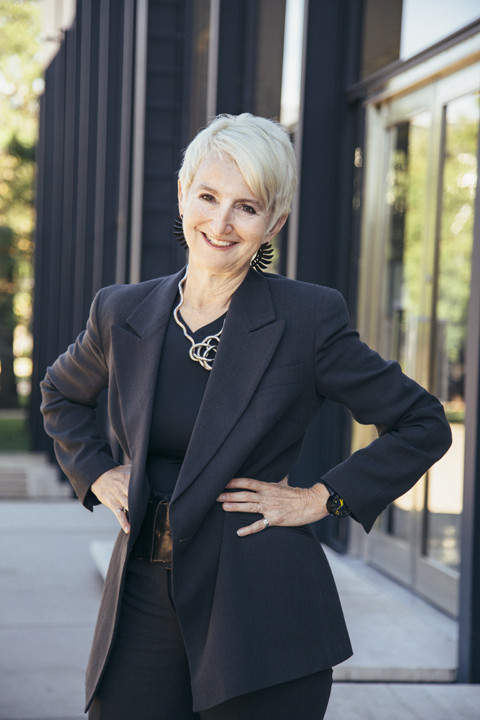“People ask me today if I always knew that I wanted to be the chief academic officer of a university,” says Frances Bronet (pronounced bron-ett), from her partially furnished, 19th-floor IIT Tower office, just over one month into her job as President Alan W. Cramb’s go-to senior administrator. “What I did know, in fact, and as a 17-year-old, was that I could recognize genius. I could recognize other peoples’ incredible intelligences and connect them, one to another.”

Even before she was aware of her interest in “navigating and brokering relationships amongst people,” the Montréal-born Bronet was a perpetual pupil—deriving information wherever possible, even shadowing her friends’ university-educated parents. An overachiever, she entered McGill University on a full scholarship and graduated with three bachelor’s degrees in architecture and engineering before earning a master’s degree from the Graduate School of Architecture and Planning at Columbia University.
Prior to coming to Chicago—“the architectural capital of the modern world”—where she lives in a Mies-designed building in Streeterville with her husband, a STEM (science, technology, engineering, mathematics) educator, Bronet last served at the University of Oregon, where she was ACSA Distinguished Professor and dean of the School of Architecture and Allied Arts. She also was acting provost during her final year.
“Frances Bronet was a visionary administrator at the University of Oregon; we expect that she will bring the same level of attentive leadership and artful exuberance to her role as provost at IIT,” says Scott Coltrane, senior vice president and provost at UO. “As dean and as acting provost she provided stability and creative inspiration to faculty, staff, students, alumni, and community members. She has the rare ability to build bridges across deep divides and to bring out the best in the people around her.”
What drew you to Illinois Tech besides the chance to live in Chicago?
I’ve always known about IIT for its renowned architecture school and for having one of the top design programs in the world; both disciplines are my foundational bailiwicks. Of course, Alan Cramb, the new president, was a huge draw. His understanding of what IIT is and what a world-class institution is and how to support it was central to my coming. In doing a little more research I began to understand the core of this extraordinary student body and the leading-edge faculty, and how they are determined to make a difference in the world while creating the tools and investigative practices by which they could make that difference. The strategic plan impressed me by its focus on students and on excellence, by the action-oriented vision and implementation strategies. Seeing the IPRO [Interprofessional Projects] Program as a fundamental model for learning, knowing that positioning design across the curriculum was in play, and that the students were already engaged in global problem solving, were critical to why I came to IIT. And the opportunities I have to further build relationships amongst the disciplines, the other universities that Chicago houses, as well as industry partnerships are incredible.
You just might have the honor of being the first person to dance at the annual IIT Faculty and Staff Family Picnic. Dance seems to have figured prominently in your work in academia. From where does that passion originate?
I grew up in the center of Montréal with limited resources in a working-class family. We had a local place that was run by the “Y” called Neighborhood House that had after-school programs, and I would hang out there; the boys would play pool, and the girls and the boys would play Ping-Pong. There was also a jukebox and so I probably spent three hours a day dancing from the ages of eight through 13. Dance was significant to me because I was able to traverse multiple cultures. I went to school in the inner city; there were certain languages that we co-used, and certainly dance was one of them.
Fast forward to my early thirties. I was trying to teach my architecture students how to understand the relationship of their bodies in space, what their drawings actually represented. We set up exercises that were based on full-scale installations. This became a theoretical enterprise for a fellow philosophy professor and me: How do we design space that allows for more than one way of occupying it? When we built dance installations, I would invite companies to do a performance in them. If three different dance companies fundamentally used the space that my students designed in a similar fashion, the students failed. The three different companies should have been able to imagine occupying the space differently. And yes, I could absolutely imagine transforming Crown Hall into a space for installation. How do you take a space that is familiar and predictable—and allow the unpredictable to occur? This already happens in Crown Hall. Those kinds of transformations are critical for me.
What are you most looking forward to working on with the IIT community?
My first year will be a big year of learning and listening for me, understanding everything we do because it’s a very rich array of arenas that we occupy. That’s exciting to me. I am energized by the unfamiliar so I’m really looking forward to gaining access to domains I don’t know that much about. I’m anticipating delving deep and building relationships with all of our university stakeholders, including developing teams across disciplines and agencies.
I especially want to learn more about our faculty’s research as well as our students’ greatest desires, and how to support them in a socially rich, creative environment. Most importantly, continuing to build along with our constituents this dynamic think tank. After all, that was my teenage dream! It clearly exists, and my goal is to figure out its components. How do we reinforce the most cutting-edge research? How do we leverage the best and the brightest faculty, staff, and students as they come here? How do we celebrate the fact that they are pursuing epic challenges together?